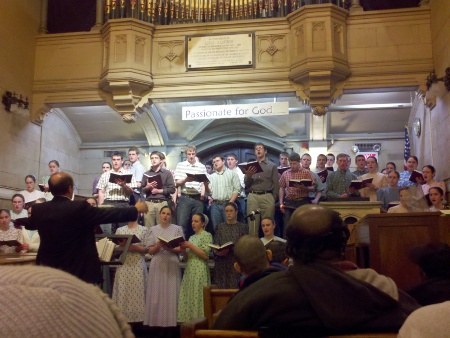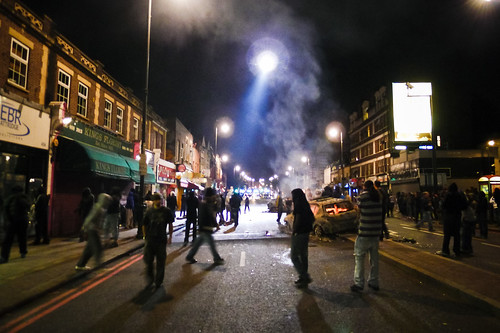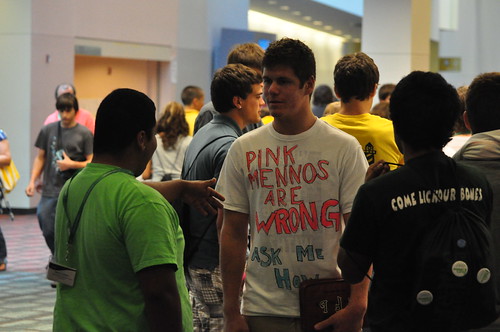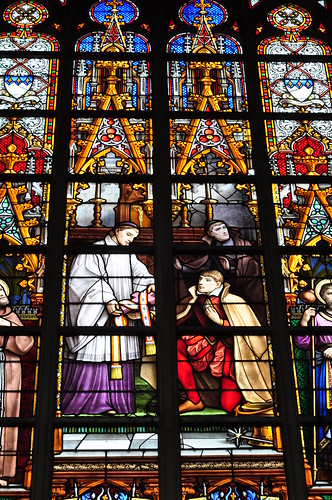(Revised November 2011)
The Sermon on the Mount is defined as the 40+ sayings of Jesus found in Matthew 5, 6 and 7. About half of those sayings are considered by scholars to be non-authentic (meaning they were likely created by the early church rather than originating with Jesus). Non-authentic sayings are not included here. Most Sermon sayings have parallels in other gospels (Mark, Luke & Thomas). Sometimes the parallels are in simpler form, and thus probably closer to what Jesus actually said. Listed below are 21 of the most authentic Sermon sayings, along with Torah passages that Jesus probably had in mind when formulating them. Similar sayings from other traditions are offered as well.
Luke 6:20: “Congratulations, you poor! God’s kingdom belongs to you.”
Compare to:
Matthew 5:3: “Congratulations to the poor in spirit! Heaven’s domain belongs to them.”
(more…)
CharlieK
November 13, 2011
Anabaptism, Awesome Stuff, Ethics, Fun, God, Group Identity, History, Interpretation, Judaism, Love, Mental health, Nonviolence, Peace & Peacemaking, Polemics, Pornography, Sex, Spiritual Life, Tactics, The Bible
Read more >
We are Marginal Mennonites, and we are not ashamed.
We are marginal because no self-respecting Mennonite organization would have us. (Not that we care about no stinkin’ respect anyway.)
We reject all creeds, doctrines, dogmas and rituals, because they’re man-made and were created for the purpose of excluding people. Their primary function is to determine who’s in (those who accept the creeds) and who’s out (those who don’t). The earliest anabaptists were also non-creedal.
We are inclusive. There are no dues or fees for membership. The only requirement is the desire to identify oneself as a Marginal Mennonite. We have no protocol for exclusion.
We are universalists. We believe every person who’s ever lived gets a seat at the celestial banquet table. No questions asked! Mystic-humanist (and anabaptist) Hans Denck was quoted saying that “even demons in the end will be saved.”
We reject missionary activity. Christian mission, historically, goes hand-in-hand with cultural extermination. We love human diversity and seek to preserve it. Thus, we oppose evangelistic campaigns and mission boards, no matter how innocuous or charitable they claim to be.
We like Jesus. A lot. The real Jesus, not the supernatural one. We like the one who was 100% human, who moved around in space and time. The one who enjoyed the company of women and was obsessed with the kingdom of God. The one who said “Become passersby!” (Gospel of Thomas 42), which we interpret as an anti-automobile sentiment. (more…)
CharlieK
November 7, 2011
Anabaptism, Awesome Stuff, Change, City, culture, Dumb Stuff., End Times, Ethics, Evangelism, Exclusion, Fun, God, Group Identity, History, Interfaith, Interpretation, Love, Mennonite Church USA, Nonviolence, Pornography, Schism, Sex, The Bible, Tolerance, Urban Ministry, Wealth, Young Folks
Read more >

Crossposted from As of Yet Untitled
It’s been a month since I wrote a piece on Young Anabaptist Radicals about my experience of visiting Occupy Chicago. It was three days after they had started camping in front of the Federal Reserve of Chicago and 10 days after Occupy Wall Street (OWS) kicked off in New York. At the time, I wrote with a mix of enthusiasm and skepticism. The visit gave me a glimpse into the sense of possibility that I remember from watching the Seattle protests but also a dose of skepticism bordering on cynicism. What could such a small group of people really do?
A month later, the answer seems clear: plenty. It still seems miraculous in many ways. While announcing the death of apathy and despair in the United States (as Michael Moore did at Occupy Oakland on Friday) is probably premature, the OWS movement has gone a long way towards tearing down the barriers that prevent so many of us from working together for change.
I’d like to share a few observations building on the framework that Steve Kryss developed in his article for the Mennonite Weekly Review. He named these parallels between the OWS movement and the Anabaptist movement that sprung up across cities in Europe nearly 500 years ago:
The Anabaptist movement emerged largely among the young. It moved through the urban contexts of educated Europeans without clarity but with a clear bent toward justice for the poor.
It emerged in and around the Peasant Revolts, which threatened established governments and religious perspectives. The radical Anabaptists were sympathetic to those whose lives were controlled by overlords.
Early Anabaptism was a movement of conversing, addressing powers and protesting. It was met with ridicule and with sympathy. There were dialogues and diatribes.
I notice three other parallels with early Anabaptism that inspire me: (more…)
TimN
October 31, 2011
Anabaptism, Corporations, Group Identity, Politics, Tactics, Young Folks
Read more >
Who knew queer anabaptists had such great stories. When I was sitting on the South Shore Line on my way to the BMC retreat I had no idea what to expect from the weekend.
“The BMC”, as it is commonly called, is short for The Brethren Council on Lesbian Gay Bisexual and Transgender Interests. I know the name is long and very forgettable but the people who are part of the BMC definitely aren’t . This year the BMC celebrated 35 years of fierceness and fabulousness. That’s nine years longer than I’ve been alive. Some of the people I met this weekend were advocating for LGBT inclusion before I knew I was gay and even before I was born. For over three decades these people’s voices have been silenced by both Mennonite and Brethren denominations and yet they keep working, keep advocating, and most surprisingly they keep laughing.
The laughing part is what most surprised me; these people have some painful stories to tell but they also have some absolutely hysterical ones. Everyone had stories to tell and so many of these stories resulted in hearty laughter. Whether it’s an awkward coming out story or taking a family picture in plain drag, these queer folk have some amazing stories. (more…)
benjaminjanderson
October 17, 2011
activism, Allyhood, Anabaptism, Anniversary, Exclusion, LGBTQ, Mennonite Church USA, Stories
Read more >
Last year I had an opportunity to visit eight Mennonite communities in the United States. I talk about it as my get-to-know-the-family tour (I haven’t been a Mennonite for very long). I am discovering that we are quite a diverse denomination. I ended up writing a series of reflections for The Mennonite Weekly Review about my experiences in these different congregations (see the column, Life of the Body).
I ended the column with a summary reflection about what it means to think of Anabaptism as a living tradition in which we can participate by being part of the Mennonite church (among other Anabaptist denominational bodies):
An Anabaptist vision that is simply an essence distilled from various histories turns our tradition into a corpse. Anabaptism as a system of principles ends up killing the past. Once we have a system, we no longer let the twists and turns of our present life give us new ears to hear what we may have missed before. Within a living tradition, old voices are made new as we let our ever-changing world open us to displays of faithfulness from different times and places. Anabaptism comes alive when we locate ourselves within cultures of worship that become spaces where stories can echo back and forth through the ages. (“Faith that lives“–not my chosen title)
Anyhow, that’s were I’ve ended up, at least for now. If you are interested in further thoughts in this direction, I put together a booklet of my reflections. It’s available at the website of the church I’m a part of: CHMF, Mennonites. But I’ll also post it here, if you’re interested:
Isaac Villegas, Life in the Body (2011). (click to download the whole booklet in pdf form)
Below are some passages from the booklet, if you want to get a taste of it to make sure its worth your while. (more…)
IsaacV
October 11, 2011
Anabaptism, Mennonite Church USA
Read more >

There’s a building boom on the Bowery these days. It’s been happening for a while, but the last couple years have witnessed an escalation in development, turning the neighborhood into a hip destination point.
Fifty years ago the Bowery was the largest skid row in the world. There were gin joints and flophouses on every block. That’s all gone now, thanks to the forces of gentrification. In their place are condos, art galleries and upscale eateries. Only one skid-row relic remains: the Bowery Mission.
Some of my earliest memories are of sitting behind the Mission’s pulpit in the 1960s, looking onto a sea of expectant faces while my father preached. In retrospect I realize the men behind those faces were awaiting the sermon’s conclusion so they could get their grub. (more…)
CharlieK
August 22, 2011
Anabaptism, Biographical, Change, Church, City, Civilization, Consumerism, culture, Current Events, Economics, Education, Ethics, Evangelism, Exclusion, God, Group Identity, History, Interfaith, Love, Mennonite Church USA, Mental health, Nonviolence, philosophy, Polarization, poverty, Power, Privilege, Race, Schism, Sex, Spiritual Life, Stewardship, Stories, The Bible, Theology, Tolerance, Tradition, Urban Ministry, Wealth
Read more >
Crossposted from As of Yet Untitled.
 Tottenham High Road by Nicobobinus Some Rights Reserved
Tottenham High Road by Nicobobinus Some Rights Reserved
Last week, riots and looting moved through neighborhoods in London that I know well. The broken windows, fires and shouts of “I want a satnav*” were juxtaposed with a familiar map that I bicycled through to work for nearly two years. I found myself turning to Facebook to reach out to friends in those neighborhoods and processing my thoughts through comments on my favorite blog.
(more…)
TimN
August 19, 2011
Anabaptism, Social Media, Technology, Young Folks
Read more >
After spending some time visiting some member congregations of Mennonite Church USA (see Life of the Body), I’m trying to think through what unifies the denomination. How do we describe our belonging to the same body of faith, the same Christian tradition?
One way that’s quite popular these days is the essentialist approach. Stuart Murray seems to be the current instantiation of this perspective. In his book, The Naked Anabaptist: The Bare Essentials of a Radical Faith (Scottdale, PA: Herald Press, 2010), Murray wants to find an “Anabaptism [that is] stripped down to the bare essentials” (15). He continues: “it is legitimate, and often helpful, to strip back the historical and cultural accretions from traditions that have persisted through the centuries” (44). His work is an “attempt to distill the essence of Anabaptism” (44). Because Stuart thinks he can strip away the husks of contemporary Mennonite communities and get to the Anabaptist kernel, he finds no reason to be in institutional communion with flesh and blood Anabaptists: “I will not become Hutterite, Amish, or Mennonite, but I am grateful that the principles of ‘naked Anabaptism’ are sometimes clothed in Hutterite, Amish, and Mennonite dress” (158-159).
(more…)
IsaacV
August 13, 2011
Anabaptism, Church, Mennonite Church USA, Tradition
Read more >
Isaac Villegas, a regular contributor to Young Anabaptist Radicals, has a new book out from Cascade Books called Presence: Giving and Receiving God. Here’s an excerpt from the book blurb:
Through a variety of sermons and meditations, Sider and Villegas bear witness to a grace that disarms our guardedness and makes room for us to fall into the love of God. Preaching becomes a dispossessive practice, as each person is invited to give and receive God’s transforming power.
�The proclamation of the gospel, Villegas and Sider say, should display the priesthood of all believers. �us, the call to preach belongs to the whole congregation and its conversation rather than to the lone preacher and her (or his) sermon. Presence: Giving and Receiving God draws on the Mennonite tradition of the Zeugnis (“conversation”) to explore how the preached Word echoes through all of our voices.
The book includes some of the posts that Isaac has posted here over the years. Congratulations, Isaac!
admin
July 21, 2011
Anabaptism, Faith, God
Read more >

This piece was originally published on my blog for The Mennonite magazine on May 9, 2011. You can read part 2 of the essay, Crisis and Conciliation here. You can read more blog posts related to the legacy of Ervin Stutzman here.
In this month’s editorial in The Mennonite, editor Everett Thomas quoted Mennonite Church USA executive director Ervin Stutzman as follows:
“The experience of Pink Mennos at Columbus in 2009,” Stutzman said, “introduced a new level of engagement in controversial matters … The techniques of social advocacy and confrontation that we have taught young adults in our schools has come to haunt our church’s most visible gathering, to the end that convention-goers feel immense pressure to take up sides against one another on [homosexuality].”
Mennonite pastor Amy Yoder McGloughlin has already written quite eloquently and diplomatically on how Ervin’s words ignore the real ghosts who haunt the Mennonite convention. So I’d like to focus particularly on Ervin’s use of the term, “haunt,” to refer to the use of social advocacy and confrontation by Pink Mennos. As a Mennonite, I find social advocacy and confrontation at the heart of the gospel and at the roots of my Anabaptist tradition. To suggest that those of us who sought to embody this tradition as Pink Mennos at Colombus were “haunting” the convention is highly problematic.
(more…)
TimN
May 9, 2011
Anabaptism, LGBTQ, Mennonite Church USA, Peace & Peacemaking, Tactics, Young FolksErvin Stutzman
Read more >
Recently, J. Denny Weaver spoke of his conversion from “passive” non-resistance and two-kingdom theology to an active stance against evil (reflection: can Mennonites use the term “evil”?) in Wisconsin. http://www.themennonite.org/issues/14-4/articles/Protesting_and_the_reign_of_God
While I approve of his stand, I must disagree with the theological conclusions of his article.
In speaking of two kingdom theology, Professor Weaver emphasizes the passive inaction of the theology. That it has nothing to say to oppression, that God is the God who empowers violence and the non-resistant have nothing to respond to injustice. Perhaps this is the form of two-kingdom theology that Professor Weaver learned, and I can see with a title like “non-resistance”, a theology might be prone to inaction. Certainly passivity is a concern among many who are raised “non-resistant”.
But two-kingdom theology is not about passivity. Certainly there is a passive aspect to it, even as Jesus said, “My kingdom is not of this world. If my kingdom were of this world, my servants would be fighting.” So there are actions that those of Jesus’ kingdom do not take. However, the foundational law of the kingdom of Jesus is active: “Love your neighbor as yourself.” Love isn’t passive, but active. Like the Samaritan in Jesus story, the one of Jesus’ kingdom cannot look at one hurt in the gutter and not act. (more…)
SteveK
April 27, 2011
activism, Anabaptism, Church, Community, Love, Nonviolence, Peace & Peacemaking, poverty, Power, Theology
Read more >

In the first article of this series, I did a broad overview of the bureaucratization trends in the Mennonite Church. In the second article, I looked specifically at the philosophy of institutions put forth by J. Lawrence Burkholder and practiced by James Brenneman and Howard Brenneman as presidents of Goshen (Ind.) College and Mennonite Mutual Aid respectively. In this third part I’ll look at the history of this thought in the Anabaptist tradition as well as Mennonite and feminist critique of Neihbur and Burkholder. I’ll continue to draw heavily from The Limits of Perfection: A Conversation with J. Lawrence Burkholder as well as The Feminist Case against Bureaucracy.
(more…)
TimN
March 21, 2011
Anabaptism, Change, Institutions, Mennonite Church USA, Power, Sexism
Read more >
Brian McLaren recently published an article addressing the question, “Is God Violent?” In it he makes a case for God’s nonviolent nature that merits a response–both internal and external–from those of us who desire to follow Jesus.
To read McLaren’s article, click here (NOTE: you will be prompted to register in order to view it).
I’ve wanted to respond to McLaren’s essay for a while.
So when the March 2011 issue of Sojourners showed up in my mailbox, I determined it was time to slow down and reflect on his propositions and the nature of God as I understand it.
McLaren frames his essay in response to the notion that God is violent, as is reflected in the Old Testament narrative and which culminates in Christ’s crucifixion at Calvary.
It’s an idea that many Christians (and Jews, and Muslims) hold true, but McLaren identifies how this profoundly impacts how we interact with one another on multiple levels.
(more…)
BrianP
February 21, 2011
Anabaptism, Faith, Nonviolence, Peace & Peacemaking, Theology, warAnabaptism, Brian McLaren, Brian Paff, creative nonviolence, Is God violent?, Laurelville, Mennonites, Nonviolence, pacifism, peace, Peace & Peacemaking, Pittsburgh 2011, Sojourners
Read more >
Last year many of you were saddened to learn that the administration at Goshen College decided to begin playing the national anthem before sporting events. A group of faculty, staff and students at the college is hosting a new website for those opposed to the decision to share life experiences that have shaped their convictions. See http://anthemCOstories.posterous.com/ .
Several stories are being posted each week, and we encourage more submissions. Stories currently posted share experiences from the U.S. as well as from conflicts in Nicaragua, Northern Ireland, and Vietnam. Events of other stories originated in Costa Rica, Uruguay, Trinidad, and Haiti. Take a look and consider sharing with others the experiences that forged your convictions about civil religion.
DougS
February 2, 2011
activism, Anabaptism, Conscientious Objection, Mennonite Church USA, patriotism, Peace & Peacemaking, Stories, warAdd new tag
Read more >
Just read this article. I feel misunderstood; but in a way they do call us out on some stuff. It’s called “Mennonite Takeover?.” What do you think?
An excerpt:
All these neo-Anabaptists denounce traditional American Christianity for its supposed seduction by American civil religion and ostensible support for the “empire.” They reject and identify America with the reputed fatal accommodation between Christianity and the Roman Emperor Constantine capturing the Church as a supposed instrument of state power. Conservative Christians are neo-Anabaptists’ favorite targets for their alleged usurpation by Republican Party politics. But the neo-Anabaptists increasingly offer their own fairly aggressive politics aligned with the Democratic Party, in a way that should trouble traditional Mennonites. Although the neo-Anabaptists sort of subscribe to a tradition that rejects or, at most, passively abides state power, they now demand a greatly expanded and more coercive state commandeering health care, regulating the environment, and punishing wicked industries.
Even more strangely, though maybe unsurprisingly, mainstream religious liberals now echo the Anabaptist message, especially its pacifism. The Evangelical Left especially appreciates that the neo-Anabaptist claim to offer the very simple “politics of Jesus” appeals to young evangelicals disenchanted with old-style conservatives but reluctant to align directly with the Left. Most famously, Jim Wallis of Sojourners, once a clear-cut old style Religious Left activist who championed Students for a Democratic Society and Marxist liberationist movements like the Sandinistas, now speaks in neo-Anabaptist tones.
ST
November 14, 2010
activism, Anabaptism, Bias, Biographical, Blog, Change, Church, communication, Community, Conscientious Objection, culture, Current Events, Discipleship, Ethics, Evangelism, Group Identity, History, Mennonite Church USA, Nonviolence, Peace & Peacemaking, philosophy, Polarization, Polemics, Power, Theology, Tolerance, Tradition
Read more >




